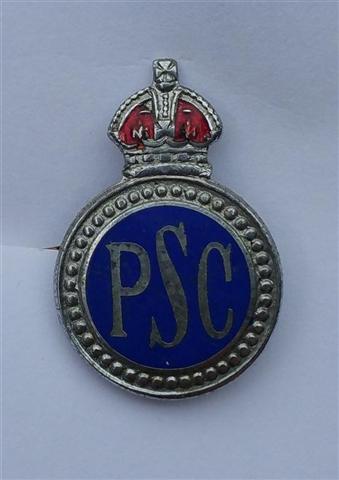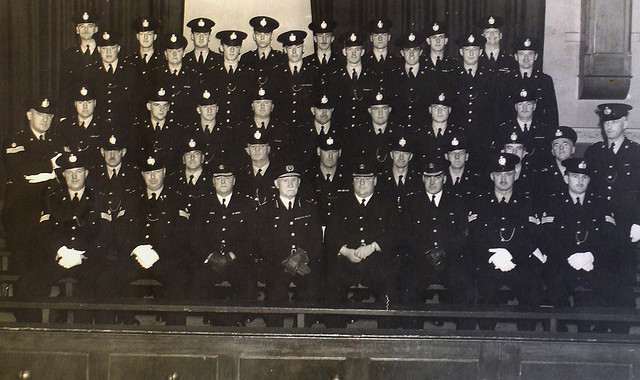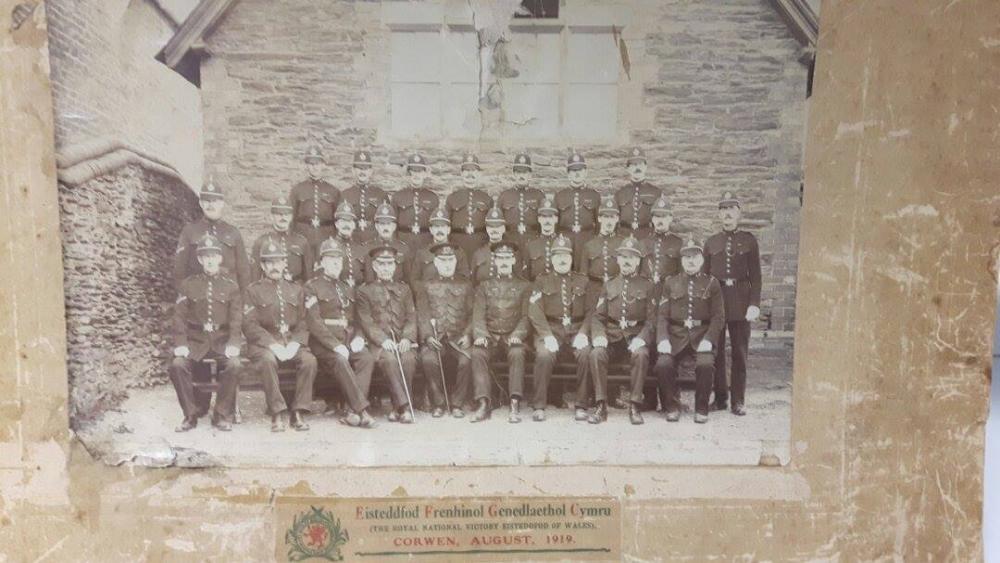
Dave Wilkinson
-
Posts
599 -
Joined
-
Last visited
-
Days Won
7
Content Type
Profiles
Forums
Blogs
Gallery
Events
Store
Posts posted by Dave Wilkinson
-
-
3 hours ago, bigjarofwasps said:
Thanks Dave, that's really interesting & sad at the same time. Especially with regards to PC Rowlands. I'd be interested to know more about the incident, where did it occur. With the subsequent amalgamations does this mean that NWP can claim his George Medal?
I seem to recall seeing a KPM (gallantry) in a display case in Wrexham station years ago. Not sure whose it was or what the circumstances of it where either?
http://www.independent.co.uk/news/obituaries/arthur-rowlands-policeman-who-was-awarded-the-george-medal-8468693.html This newspaper report suggests that "He and the three colleagues who arrested his assailant were awarded the George Medal." Are the other two Officers known?
Gordon,
The incident took place in August 1961 on the outskirts of the village of Machynlleth which was then in Merionethshire. Constable ROWLANDS was shot at the scene by Robert BOYNTON. There was a subsequent manhunt which lasted several days through the mountains and which involved a large number of police officers who were sent to assist the Gwynedd Constabulary. Arising out of the incident there were four George Medals awarded and two British Empire Medals for Gallantry. The recipients were as follows:-
GEORGE MEDAL.
Constable Robert CARSWELL - Liverpool City Police.
Constable Thomas Owen DAVIES - Mid-Wales Constabulary.
Constable Robert William ROBERTS - Shropshire Constabulary.
Constable Arthur Rees ROWLANDS - Gwynedd Constabulary.
The two BEM Gallantry medals were awarded to a Sergeant and a Constable of the Mid-Wales Constabulary.
If anyone wishes to read the full circumstances of the incident please "google" the Liverpool City Police history website. Under "Roll of Honour" you will see "Robert CARSWELL". Click on that and you are there.
Dave.
0 -
The information published on page 9 of the book "Staffordshire Police 150th Anniversary" states, "Whilst Captain Anson (Chief Constable), did not consider a detective branch throughout the county to be a necessity, he saw the advantages to be gained by employing officers on plain clothes duties. Accordingly, in 1894 he gave authority for ten constables to be engaged on enquiry and detective duties. These enquiry officers were paid a plain clothes allowance of four pence (2p) a day". The book is published by Staffordshire Police and is compiled using a number of archive sources including the minutes of the Standing Joint Committee.
Its worth bearing in mind that an individual seeking marriage could and can describe his/her "job" using whatever title he/she pleases. Perhaps Mr. Moreton occasionally did duty in plain clothes and took the view that whilst so dressed he was engaged in detective work. This practice may have been the norm prior to the year mentioned, or you man simply decided that "detective" on his marriage certificate sounded rather impressive. I hope this is helpful.
Dave.
0 -
Can't comment upon the first part of your question. However, the Docks in London were owned by the Port of London Authority and were policed by their own non-Home Office police force.
Dave.
0 -
They certainly do. I administered the issue of the Golden Jubilee medals to the force I was serving with at the time (Port of Dover Police). The completed nominal role with signatures in receipt alongside was forwarded to the Secretary of State for Transport who I understand transmitted them, together with those from the other Port Police Forces, the BTP and the Mersey Tunnels Police to the National Archives. Whether the National Archives have produced one complete list or simply retained the lists submitted by each force, I know not.
Dave.
0 -
An interesting photo Lawrence. Thanks for sharing it. Can't imagine that helmet being very popular with the gents who were required to wear it. I suspect that there may have been some "micky taking" by the public and his mates!
Dave.
0 -
1 hour ago, Swainys Boy said:
Lawrence,
No, I'm not aware of an SC badge for Huntingdon town itself. I already have the HSC badge otherwise I would take it off you.
Dave.
0 -
Lawrence,
It was much easier to chop out the old cipher from the centre and put a new one in than to pay to have the Crowns taken off as well. Or perhaps there were technical reasons why the Crowns could not be cut off and easily replaced. Its a chrome badge and the application of too much heat would risk damaging the enamel and discolouring the chrome. If there was a QC version floating about locally then your Dad would have had it. I do know that he tracked down all the old Inspectors years ago and spoke to the families of those who had gone, without success.
Dave.
0 -
35 minutes ago, Swainys Boy said:
... May I say what a fantastic thread and thank you for all who have contributed so far, I have learnt MUCH!
A question arises... I have a WW2 PSC badge which is undoubtedly for Peterborough Special Constabulary. I have just bought off of ebay for a reasonable price of £10.99 an identical looking badge HSC. Am I to reliably believe that this is for Huntingdon or Huntingdonshire being the town is so close to Peterborough?
Hi Lawrence,
The "PSC" is indeed from Peterborough as you correctly say. Disappointingly, the "HSC" badge is from Hampshire. Huntingdonshire has a similar badge but with the Coat of Arms in the centre and "Huntingdonshire Special Constabulary" around the outside.
Dave.
0 -
I'm sure someone with access to Metpol. records will oblige. You probably stand a better chance with a Metpol. war reserve than any other force.
Dave.
0 -
It depends upon the force. Some have excellent records others none at all.
Dave.
0 -
Lawrence,
There were several forces who used a white "tunic" jacket. As far as I'm aware they were only worn on traffic direction duty and not (as Peterborough intended) for everyday street patrol wear. The exception I believe was in Jersey (Channel Islands) were prior to 1972 they wore them with a white helmet during the summer. The only difference was that theirs has a "stand collar" as opposed to an open neck one. I have an identical one to yours from Liverpool City Police.
Best wishes, Dave.
0 -
Hi Lawrence,
The Peterborough Inspectors badge is absolutely correct. The force sent back to the manufacturers the KC GVIR centred Inspectors badges, when the old King died and had the GVIR removed and replaced with the (then) new Queen's cipher. Several forces did this. I have a hallmarked sterling silver version of the same badge which would have been worn by the Superintendent (he was also the Deputy Chief Constable). Peterborough did eventually have a small number of the correct QC EIIR version of the badge made. This is almost impossible to find. I don't have one and I don't think Dad was able to find one either.
The Northamptonshire (incorrectly spelt) badge was issued and they were all recalled when the mistake was spotted. Most were destroyed but probably half a dozen survived. Again, that is a difficult one to find with the missing "p". The story which you relate is, I believe correct.
That's a nice photo of the old boy which you've used. Just as I remember him!
Best wishes, Dave.
0 -
This is the final force photograph of the entire Merionethshire Constabulary taken on the 30th September 1950. At midnight the force ceased to exist. Chief Constable Richard Jones retired at the same time. As an aside, they ceased to wear helmets at the end of the 2nd WW. Fourth from the right on the back row is Constable Arthur Rowlands who years later was to be awarded the George Medal following his being shot in the face (and blinded) by a suspected burglar, Robert Boynton.
Dave.
0 -
3 hours ago, bigjarofwasps said:
There is a consensus that perhaps all the Bobbies in this picture weren't all stationed at Corwen, but had been drafted in just for the Eisteddfod. I'm not sure myself, they all seem to have C on their collars, which I assume is for Corwen? If you break them down into rotas (excluding the senior officers), 7 on a rota perhaps 3 rotas, seems to be 3 Sgt's in their and a couple of Lance Jack's. Not entirely sure what they are, senior Bobbies I assume?
I have looked at two old Police & Constabulary Almanacs, for 1902 and 1936. The strength of the force in both years is 35 men (all ranks). I've had a close look at the photo and there are 26 gents on it. I think what you have on that photo is the entire Merioneth Constabulary minus those covering the rest of the county, leave, sick etc. The Sergeants and Constables all have "MC" on their collars together with their force number. For most of its existence the force had three divisions, Dolgelley (16 men, 10 stations), Festiniog (12 men, 8 stations) and Bala (7 men, 5 stations). Each division was commanded by an Inspector. Force HQ was at Dolgelley. Corwen was a Sergeant's station and was situated in Bala division. The men would have all been required to live at their stations, most being a one man posting with 24 hour responsibility. Young single men probably lodged with a Sergeant or a Senior Constable. There would not have been a three shift system as we know it today. As an aside, Bala division had two magistrates courts which sat at Bala (2nd and last Saturday of each month) and Corwen (the last Friday of each month). Prosecutions were conducted by the divisional Inspector. An interesting insight into a long lost era of rural policing.
Dave.
0 -
Hi Gordon,
No I'm not aware of any from the forces in North Wales. Obviously all good loyal lads!
Dave.
0 -
4 hours ago, The Station Cat said:
955!!!!! I had no idea!!!!
Which other forces were involved?
955 was actually half the force. They were warned by the Head Constable that if they did not report for duty at their stations by a particular time on a given date in August 1919, that he would immediately "sack" those who did not do so. 955 men (Sergeants and Constables) stayed on strike and were immediately dismissed. None were ever reappointed and all lost their pensions. There were some strikers in Birkenhead and Bootle and one man (I think) went on strike in Wallasey. I'm not sure how many were dismissed in those forces.
Dave.
0 -
Gordon,
Having the names would be great! In theory the medals should still be floating around the North Wales area. That said, the odds on them being named are slim. The front and back of my photo are shown below. I think the frame is original and untouched since the framing was done in 1911. I wonder if the names are on mine (on the back of the card mount)? I don't intend opening it to find out!
Dave.
0 -
12 hours ago, bigjarofwasps said:
I have an original framed identical photo. Interestingly, the Chief Constable (centre front row) is Richard Jones. Mr. Jones was appointed Chief Constable of Merionethshire on the 8th May 1911 and served as Chief until the force was amalgamated on 30th September 1950. An amazing length of continuous service for a Chief Constable.
Dave.
0 -
12 hours ago, bigjarofwasps said:
I was going to say it wasn't just the Met that went on strike, although they do appear to have drawn most of the lime light. There's a book called `The Night the Police went on strike` by Gerald W Reynolds & Anthony Judge, that is well worth a read.
In addition to the book you mention, there is another dealing primarily with Liverpool City Police, "Police Strike 1919" by A.V. Sellwood. There were 955 Liverpool strikers dismissed.
Dave.
0 -
13 hours ago, The Station Cat said:
Is there a roll for all the Officers dismissed after this strike?
Did they have their medals revoked?
There is a general assumption that only the Met. went on strike which is not a correct one to make. A number of provincial forces also were affected. There is no central "roll" of those who were dismissed and you would need to consult local (provincial) archives depending upon the force in which you were interested. Again, I think local policy dictated whether medals were revoked.
Dave.
0 -
It is worth bearing in mind that in 1911 Corwen was NOT in Denbighshire but in Merionethshire. So, I think your enquiry should perhaps relate to the former Merionethshire Constabulary. Local government re-organisation later placed Corwen in Denbighshire. I hope this is helpful.
0 -
Many thanks for that information. I suspected as much but was not sure.
Dave.
0 -
3 hours ago, bigjarofwasps said:
I am understanding this correctly, that the numbers and letters on these helmet plates are interchangeable? I had always assumed that they were cast, but having them interchangeable certainly makes more sense.
Just out of interest, should I ever track one of these helmet plates down (I've never seen any for sale), how much should I look at paying for one?
It's also interesting to learn that they continued to use the Victoria version after she'd died and didn't replace them straight away with a Kings Crown version.
The divisional letters and the numbers are indeed removable, and interchangeable between plates.
The King's Crown versions have been selling on the internet auction site for £200 plus. I've not seen a Victorian example offered for sale but I would imagine that it would attract quite a bit of interest and an appropriate hammer price.
0 -
I suspect that PC Hayward was one of many who over the years completed their service in one division, retaining the same number. I imagine that it must be quite rewarding to put a name to a Met. man in an old photo as a result of tracing his number and division through records, AND narrowing it down to only one possible individual. But then given the size of the force and the turnover of men (particularly in the early days), such occasions must be few and far between. Insofar as the Dockyards are concerned I'm not sure whether each dock division maintained a separate numbering system or whether they were consecutively issued to cover all the Dockyards. In other words, was there a PC 30 at Chatham and another PC 30 at Devonport ? That said, unless you could ID the location then I guess that putting a name to the guy would be just as difficult for the reasons you mention.
Dave.
0






Merioneth Constabulary at Corwen 1919
in Great Britain: Mervyn Mitton's British & Colonial Police Forces
Posted
Gordon,
Many thanks to you for the time you've taken in transcribing that information. Looking at the old almanacs which I have it would appear that the officer sitting to the left of the Chief Constable is Supt. D.T. Morgans. I do wish that the people of Wales would have been a little more inventive with their surnames. That said, first names seem no less varied. Bless them!
Dave.